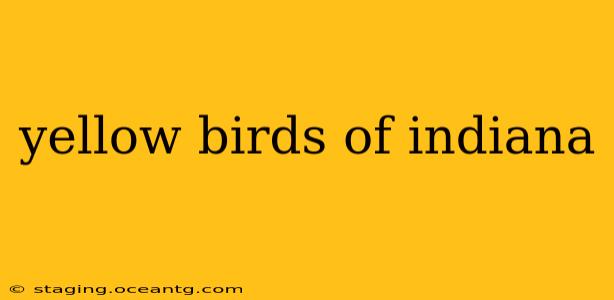Indiana, with its diverse habitats ranging from forests and prairies to wetlands and urban areas, is home to a surprising variety of yellow birds. Spotting these vibrant creatures can be a highlight of any nature walk or backyard birdwatching session. This guide will explore some of the most common yellow birds found in Indiana, providing identification tips and insights into their behaviors and habitats.
What are some common yellow birds found in Indiana?
Several species boast striking yellow plumage, either entirely or partially. Some of the most frequently seen include the American Goldfinch, the Yellow Warbler, the Northern Flicker (which exhibits yellow markings), and the Eastern Meadowlark (with its characteristic yellow breast). Identifying them requires attention to detail, looking beyond just the yellow coloration.
Where can I find yellow birds in Indiana?
The location where you're most likely to spot a specific yellow bird depends heavily on its preferred habitat. For example:
-
American Goldfinches: These birds frequent weedy fields, meadows, and open areas, often near feeders in the backyard. Their preference for seeds makes them regular visitors to sunflower and thistle feeders.
-
Yellow Warblers: These lively birds are typically found in woodlands, especially near water sources. They prefer deciduous forests with dense undergrowth.
-
Northern Flickers: These woodpeckers are more adaptable and can be found in a wider range of habitats, including woodlands, parks, and even suburban areas. Look for them on trees and utility poles.
-
Eastern Meadowlarks: As their name suggests, these birds favor grasslands, meadows, and open fields. They're often found in agricultural areas and pastures.
What are the best times of year to see yellow birds in Indiana?
The best time to see yellow birds in Indiana largely depends on the species and their migratory patterns.
-
Migratory birds, such as the Yellow Warbler, are most commonly seen during their spring and fall migrations (April-May and September-October).
-
Resident birds, such as the American Goldfinch, can be observed year-round, although their plumage may vary slightly depending on the season. Breeding plumage is often brighter.
-
Northern Flickers are year-round residents, but their visibility can fluctuate based on seasonal food availability.
What do yellow birds in Indiana eat?
The diet of Indiana's yellow birds varies widely depending on the species:
-
American Goldfinches: Primarily consume seeds, particularly those from thistles and sunflowers.
-
Yellow Warblers: Primarily insectivores, feeding on insects and spiders found among foliage.
-
Northern Flickers: Their diet is varied, consisting of ants, beetles, and other insects, as well as berries and seeds. They are known for their ability to forage on the ground.
-
Eastern Meadowlarks: Primarily feed on insects and seeds found in grasslands and fields.
How can I attract yellow birds to my backyard in Indiana?
Attracting yellow birds to your backyard involves providing the resources they need:
-
Food: Offering appropriate food sources is crucial. Sunflower seeds, thistle seeds, and suet can attract goldfinches and flickers. Planting native flowering plants that attract insects will help attract warblers.
-
Water: Provide a clean source of water for bathing and drinking, such as a birdbath or shallow dish of water.
-
Shelter: Planting native shrubs and trees provides cover and nesting sites.
What are some interesting facts about yellow birds in Indiana?
The vibrant yellow coloration of many of these birds often serves as a signal to attract mates or warn off rivals. The male American Goldfinch, for example, displays a particularly bright yellow plumage during the breeding season. The songs and calls of these birds are also distinctive and contribute to their identification. Observing their behavior, noting their habitat preferences, and understanding their dietary needs are all essential aspects of successful birdwatching in Indiana.
